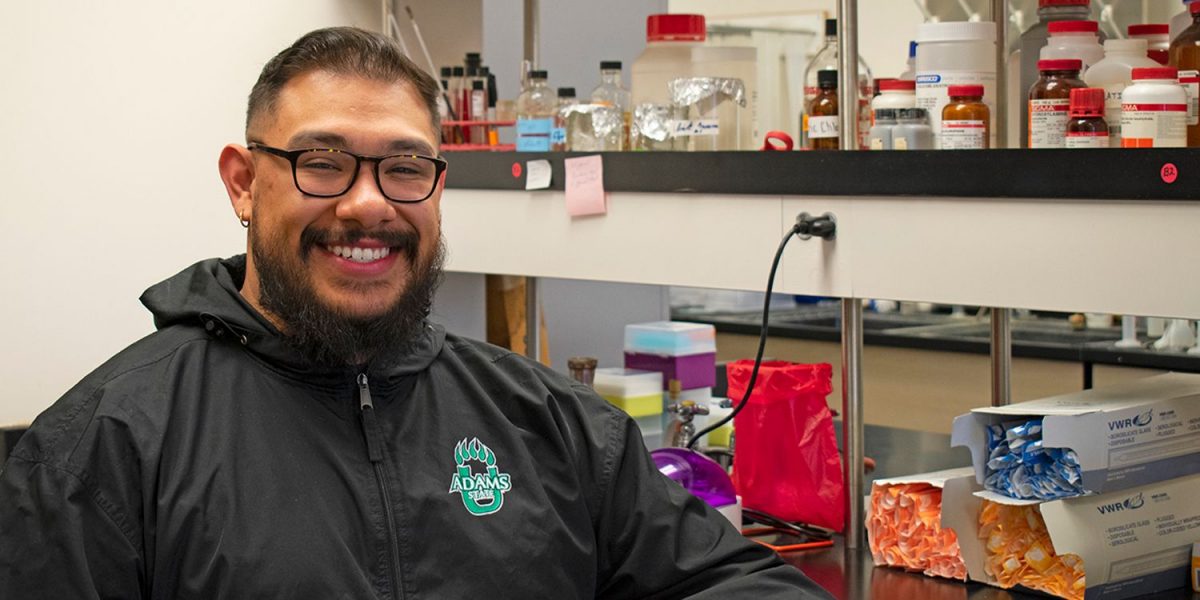A native of Los Angeles, Pablo Maldonado understands first-hand that Adams State University offers degrees that matter. Always eager for a challenge, Maldonado accepted an opportunity to conduct relevant research through the Prevalence of Antibiotic Resistance in the Environment (PARE) Project. “I came into the lab on my own, set my own deadlines with certain experiments and reported to Dr. K with results.”
According to Dr. Adam Kleinschmit (Dr. K), Adams State associate professor of biology, the emergence of antibiotic-resistant infections has been declared a contemporary worldwide threat to public health by the World Health Organization. When antibiotics are used in residential, clinical and/or agricultural settings, the surrounding environment is indirectly exposed due to unmetabolized and excreted drugs, improper disposal of unused prescriptions, and agricultural run-off spread through waterways. These antibiotic pollutants, in turn, can select for the persistence of resistant microbes in the affected environment.
Calls from public-health stakeholders have included requests for standardized environmental surveillance systems to track levels of antibiotic-resistant microbes in hopes that the resulting data will allow researchers to more clearly understand the prevalence of environmental-resistance reservoirs, horizontal transfer of resistance determinants, and potential correlations with clinically relevant pathogens.
In response to this call, the PARE Project was developed by Carol Bascom-Slack at Tufts University to harness the power of undergraduates working in parallel across many institutions to identify environmental resistance hotspots and identify potential correlations with geography and land-use policies, while providing students with an authentic research experience embedded within the classroom.
“We are currently working to develop an expansion research module to investigate the nature of tetracycline resistance in isolated bacterial strains,” Kleinschmit said. Specifically, they focus on acquired resistance due to microbial procurement of genetic resistance determinants (i.e., genes).
Maldonado optimized thermal cycling conditions for select tetracycline resistance gene primers, with metagenomic DNA extracted from tetracycline resistant microbial communities that can be used in a novel research module by undergraduates across the country to screen for known antibiotic resistance genes in environmental bacterial isolates.
This spring, Maldonado presented this research, Assay Development and Characterization of Tetracycline Genetic Resistance Determinants from Environmental Samples at the Annual Student Scholar Days. “Beyond prevalence data, identifying which antibiotic resistant determinants are present in environmental samples can aid in efforts to determine the origin of exposure and the mechanism of action,” he added.
This is the second research project Maldonado completed at Adams State and this summer he will help with a 10-week research initiative at CSU Fort Collins under Dr. Debbie Crans. “I hope that these opportunities will make me a very well rounded candidate for graduate school.” He is currently pursuing a double major: Bachelor of Science in biology and a Bachelor of Arts in chemistry, with an expected grad year of 2020.
Support for the research came from support from the Colorado Louis Stokes Alliance for Minority Participation (CO-AMP). CO-AMP is an innovative consortium of fifteen community colleges, four-year institutions, and four Native American tribes in Colorado and the Four Corners region working to increase the number of underrepresented minorities earning bachelor’s degrees in Science, Technology, Engineering or Math (STEM). CO-AMP is funded by a grant from the National Science Foundation with Colorado State University as its headquarters.



